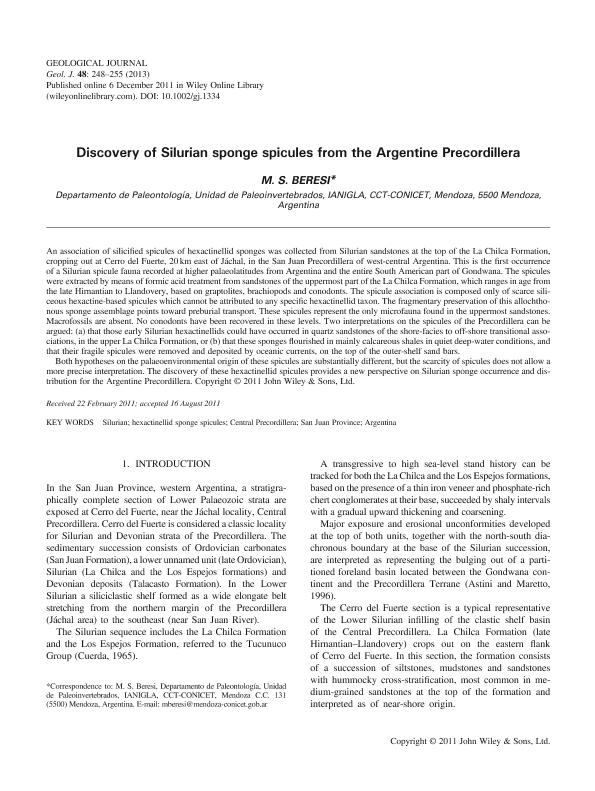Mostrar el registro sencillo del ítem
dc.contributor.author
Beresi, Matilde Sylvia

dc.date.available
2016-03-17T18:50:08Z
dc.date.issued
2011-12-06
dc.identifier.citation
Beresi, Matilde Sylvia; Discovery of Silurian sponge spicules from the Argentine Precordillera; Wiley; Geological Journal; 48; 2-3; 6-12-2011; 248-255
dc.identifier.issn
0072-1050
dc.identifier.uri
http://hdl.handle.net/11336/4850
dc.description.abstract
An association of silicified spicules of hexactinellid sponges was collected from Silurian sandstones at the top of the La Chilca Formation, cropping out at Cerro del Fuerte, 20 km east of Jáchal, in the San Juan Precordillera of west-central Argentina. This is the first occurrence of a Silurian spicule fauna recorded at higher palaeolatitudes from Argentina and the entire South American part of Gondwana. The spicules were extracted by means of formic acid treatment from sandstones of the uppermost part of the La Chilca Formation, which ranges in age from the late Hirnantian to Llandovery, based on graptolites, brachiopods and conodonts. The spicule association is composed only of scarce siliceous hexactine-based spicules which cannot be attributed to any specific hexactinellid taxon. The fragmentary preservation of this allochthonous sponge assemblage points toward preburial transport. These spicules represent the only microfauna found in the uppermost sandstones. Macrofossils are absent. No conodonts have been recovered in these levels. Two interpretations on the spicules of the Precordillera can be argued: (a) that those early Silurian hexactinellids could have occurred in quartz sandstones of the shore-facies to off-shore transitional associations, in the upper La Chilca Formation, or (b) that these sponges flourished in mainly calcareous shales in quiet deep-water conditions, and that their fragile spicules were removed and deposited by oceanic currents, on the top of the outer-shelf sand bars. Both hypotheses on the palaeoenvironmental origin of these spicules are substantially different, but the scarcity of spicules does not allow a more precise interpretation. The discovery of these hexactinellid spicules provides a new perspective on Silurian sponge occurrence and distribution for the Argentine Precordillera.
dc.format
application/pdf
dc.language.iso
eng
dc.publisher
Wiley

dc.rights
info:eu-repo/semantics/openAccess
dc.rights.uri
https://creativecommons.org/licenses/by-nc-sa/2.5/ar/
dc.subject
Silurian
dc.subject
Spicules
dc.subject
Precordillera
dc.subject
San Juan
dc.subject
Hexactinellid Sponge Spicules
dc.subject
Central Precordillera
dc.subject
San Juan Province
dc.subject
Argentina
dc.subject.classification
Paleontología

dc.subject.classification
Ciencias de la Tierra y relacionadas con el Medio Ambiente

dc.subject.classification
CIENCIAS NATURALES Y EXACTAS

dc.title
Discovery of Silurian sponge spicules from the Argentine Precordillera
dc.type
info:eu-repo/semantics/article
dc.type
info:ar-repo/semantics/artículo
dc.type
info:eu-repo/semantics/publishedVersion
dc.date.updated
2016-03-30 10:35:44.97925-03
dc.journal.volume
48
dc.journal.number
2-3
dc.journal.pagination
248-255
dc.journal.pais
Estados Unidos

dc.journal.ciudad
Hoboken
dc.description.fil
Fil: Beresi, Matilde Sylvia. Consejo Nacional de Investigaciones Científicas y Técnicas. Científico Tecnológico Mendoza. Instituto Argentino de Nivología, Glaciología y Ciencias Ambientales; Argentina
dc.journal.title
Geological Journal
dc.relation.alternativeid
info:eu-repo/semantics/altIdentifier/url/http://onlinelibrary.wiley.com/doi/10.1002/gj.1334/abstract
dc.relation.alternativeid
info:eu-repo/semantics/altIdentifier/doi/http://dx.doi.org/10.1002/gj.1334
dc.relation.alternativeid
info:eu-repo/semantics/altIdentifier/doi/10.1002/gj.1334
Archivos asociados
